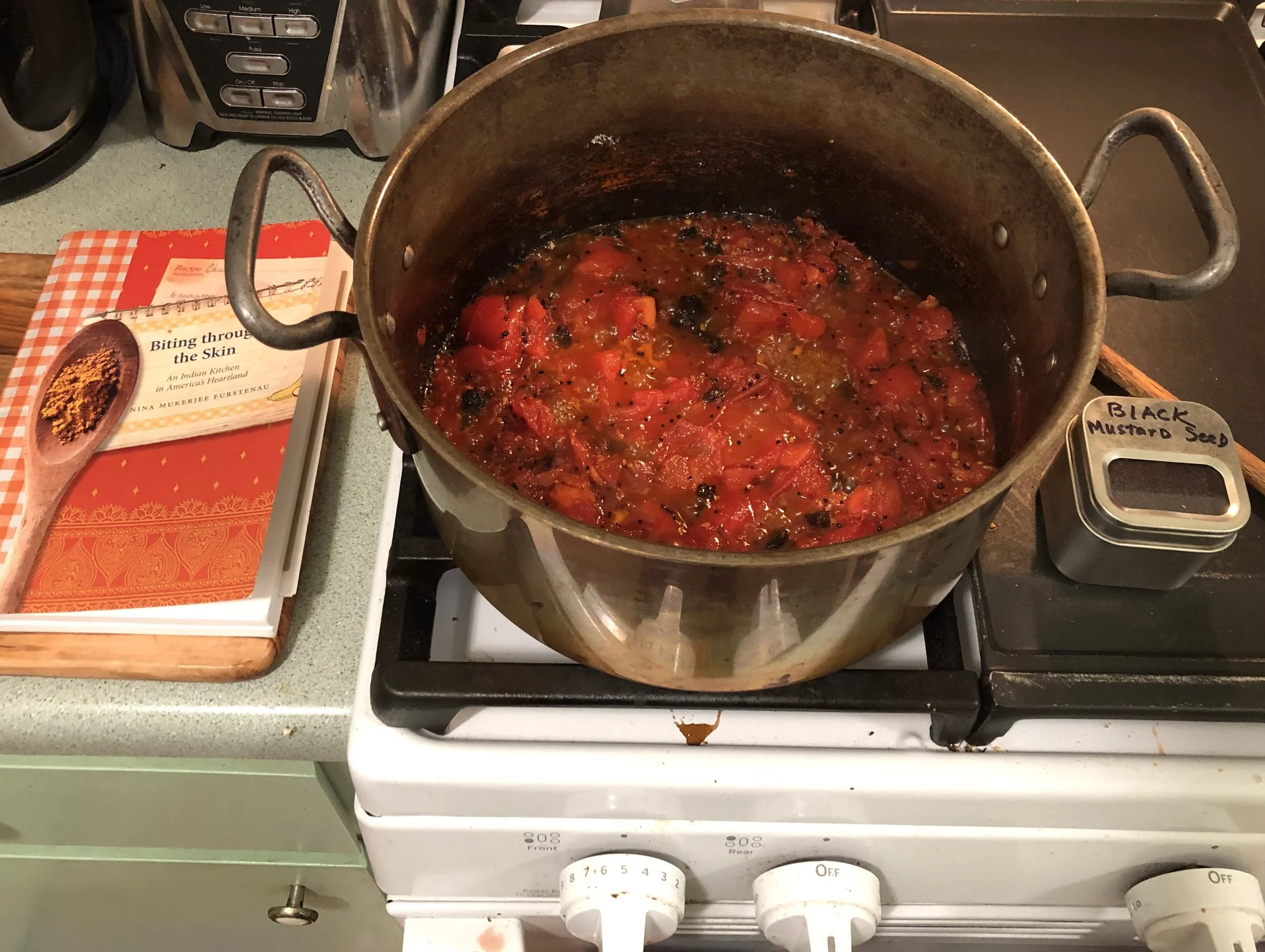Cooking with Nina
There is something to be done in this season. Something to be done. So Nina’s memoir begins.
In my friend Nina’s kitchen and fertile writer’s mind, there are traces of distant other worlds and, she will tell you, something is always combusting. While preparing recipes from her mother’s Indian kitchen, the idea for a memoir took shape. The food and geographic images in her memoir bridge two worlds—that of her Bengali parents and grandparents and the rural Midwestern town of Pittsburg, Kansas where she spent her childhood as Nina Mukerjee in the 1960s.
Nina cooks and writes on the midwestern farm near Fayette, Missouri that she shares with her husband Terry Furstenau as well as in their home in Columbia. Her culinary memoir Biting Through the Skin: An Indian Kitchen in America’s Heartland was chosen as a top pick for Kansas’s Notable Book of 2014. That same year, Nina was awarded the Les Dames d’Escoffier International Grand Prize and MFK Fisher Book Award for Excellence in Culinary Writing. She has since traveled to India on a Fulbright Scholarship where she researched her second book, Green Chili and Other Impostors. More recently she has led food trips to Italy, Portugal, Chicago, and various other regional food destinations around the country. Nina is also a founding member of The Common Ingredient—a website, food blog and newsletter that promotes food security—established in 2020. [www.thecommoningredient.com]
In the author’s note of Biting Through the Skin, Nina explains that her book is “a memoir that takes place primarily during what Virginia Woolf called “the great Cathedral space which was childhood.” It is a beautiful journey through food which Nina recounts, inspired by her mother’s Bengali family recipes written on food-stained recipe cards and infused with the delicious language of Indian spices. The Indian names of her mother’s recipes roll off my tongue like years falling away—Murgi (Chicken Curry), Rainy-Day Khichuri (Rice and Lentils with Vegetables), and Taetul Chatni (Tamarind/Date Chutney).
Nina and I share emails often, and recently we recalled how we first met when she and two friends from Fayette, MO had a shop called they named à la campagne. It was a place filled with international antiques, fine art, furnishings, bottles of herb flavored olive oil, aromatic spices and soaps, and a small collapsible zinc bar that I could not resist after reading about Egyptian zinc bars in Michael Ondaatje’s novel The English Patient.
I told her of my piles of apples, plums and tomatoes ready to be sliced, roasted, stewed, or made into chutneys. After writing in a recent blog about my favorite Missouri tomato chutney recipe and sharing an Italian apple cake recipe, she reminded me of her mother’s Bengali tomato chutney recipe with black mustard seeds.
Nina wrote, “Tomato chutney was a homey favorite in my mother's kitchen and your recent blog about tomato chutney landing in the Missouri governor's mansion years ago, then ending up in your recipe collection and kitchen warms the heart. Mom's was made with black mustard seeds rather than the warming spices of cinnamon and cloves, an alternative you might test out sometime.”
My first challenge after deciding that I was going to make her mother’s version of tomato chutney was to find black mustard seeds. My search took me to a chest that I created a few years ago of assorted spices from the Indian Subcontinent. Once found, I had all of the ingredients I needed for Tomato Chatni (Tomato Chutney).
Serves 6-8
Ingredients:
1 ½ tablespoons vegetable oil
1 teaspoon black mustard seeds
5-6 tomatoes cut into chunks
¾ cup sugar
¼ cup raisins
1 tablespoon lemon juice, or more to taste
Directions:
Heat oil in a saucepan.
When hot, add mustard seeds and let sizzle for 20 seconds.
Add tomato pieces and fry for 2 minutes.
Reduce temperature to medium-low and simmer about 10 minutes.
Add sugar and mix well.
Continue simmering gently another 10 minutes.
Add raisins and simmer another 10 minutes until the chutney begins to thicken.
Take pan off heat and add lemon juice.
Serve at room temperature or chilled.
Nina’s memoir also includes her mother’s recipe for Apple Chatni (Apple Chutney). Reading it triggered food memories of when I first arrived in Thailand in 1967 at the age of 21 and lived in a small house with a tamarind tree. Soon I will make her mother’s Tamarind/Date Chutney with tamarind paste and delicious, fresh Medjool dates. My neighbor Mindy just dropped off a bag of gorgeous apples that she picked from her own tree just up the road from our house. Pots of apple chutney with tamarind paste will be next.
In your own kitchen stock up on turmeric, cardamom powder and pods, curry powder, cumin, ground ginger, chickpea flour, tamarind, dates, dal, ghee, lamb, yogurt and naan. What better month than October to introduction to the magic of ingredients both hot and sweet, peppery and mild, ordinary and exotic flavors that once combined combust in the most delicious way in a single pot.
[To learn more about Nina Mukerjee Furstenau’s bio, books, food trips and travels, and blog, visit her website at www.ninafurstenau.com]






